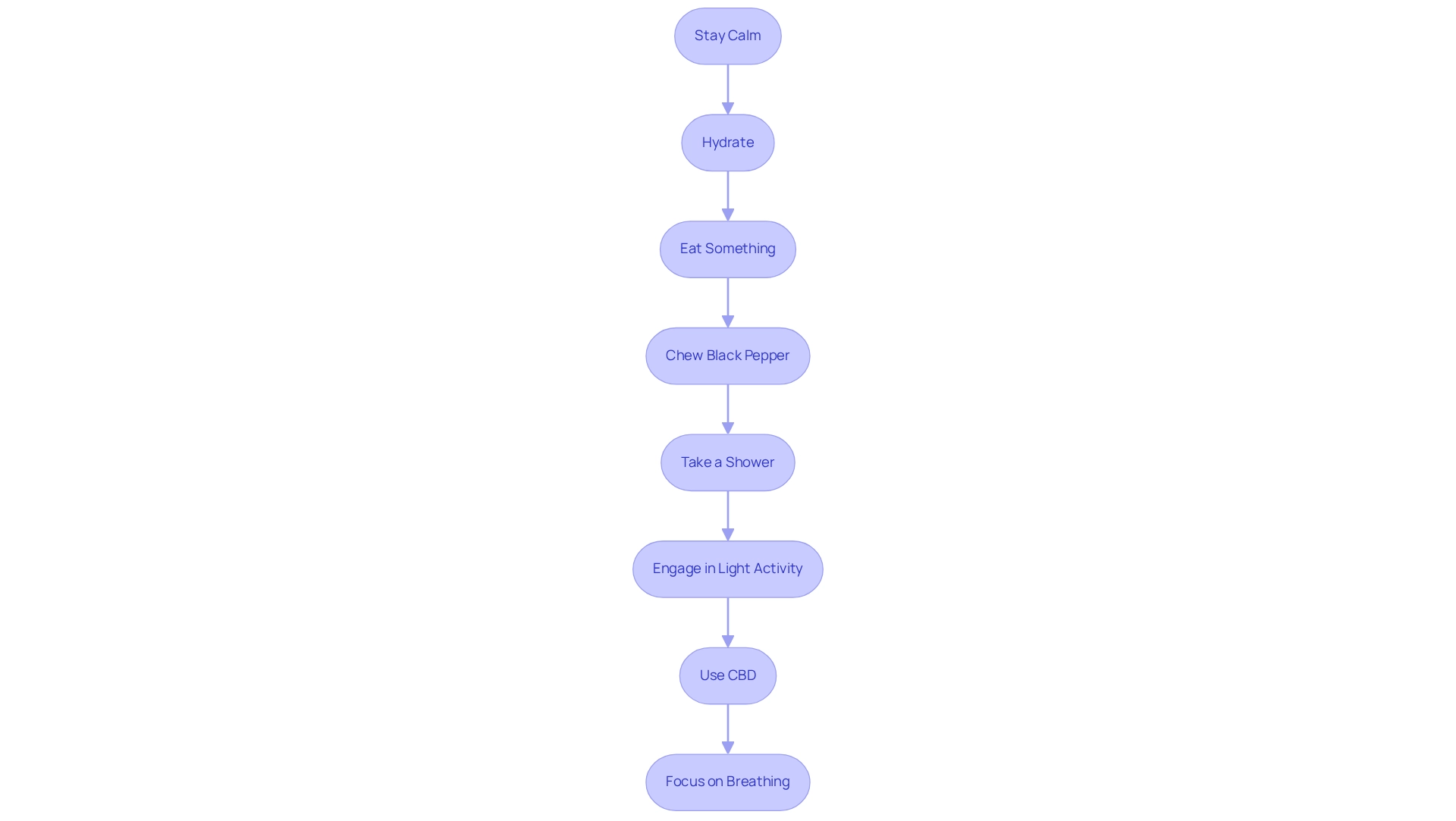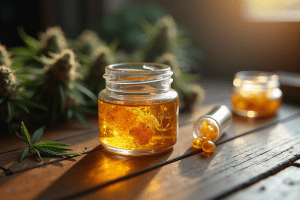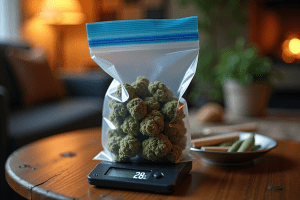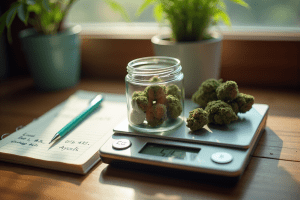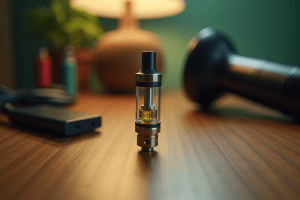Overview
This article offers immediate steps and long-term strategies for those of us looking to ease the discomfort of being overly high from cannabis. It highlights practical methods, such as staying calm, hydrating, and eating, which can quickly help alleviate discomfort.
Moreover, it advocates for education on different strains, setting personal consumption limits, and developing healthy coping mechanisms. These strategies are essential for achieving sustained sobriety in the long run.
Have you ever felt overwhelmed after consuming cannabis? You’re not alone. Together, we can explore these strategies to find what works best for you. Let’s take informed steps towards a more balanced experience.
Introduction
Navigating the world of cannabis can feel overwhelming, especially for those who are new to its effects and nuances. As cannabis gains popularity, it becomes crucial for us to understand how its active compound, THC, interacts with our bodies. Have you ever experienced euphoria or altered perceptions? Perhaps you’ve noticed heightened heart rates or cognitive shifts? These experiences can vary widely among users, and it’s important to recognize that you’re not alone in this journey.
This article explores the multifaceted effects of cannabis, offering immediate steps to help you feel more at ease, as well as long-term strategies for maintaining a balanced and informed approach to consumption. Together, we can equip ourselves with knowledge and practical tips, enhancing our overall cannabis experience while promoting responsible use. Remember, understanding is the first step towards making informed choices that align with your needs.
Understand the Effects of Cannabis on Your Body
Cannabis exerts its primary effects through its active compound, tetrahydrocannabinol (THC), which interacts with cannabinoid receptors throughout the brain and body. This engagement can lead to a range of outcomes that vary significantly among users:
- Euphoria and Relaxation: Many find themselves enveloped in heightened feelings of joy and tranquility, which can be delightful, yet may also become overwhelming in certain situations. Remember, staying hydrated during use is essential.
- Altered Perception: Consuming cannabis often alters sensory perceptions, making colors seem brighter and sounds more profound, creating a unique experience that can sometimes feel disorienting.
- Increased Heart Rate: THC may cause a temporary increase in heart rate, which can lead to feelings of anxiety or panic, especially for those who are inexperienced or particularly sensitive.
- Cognitive Impairment: Users might face challenges with memory, attention, and coordination, potentially affecting their daily activities.
- Physical Reactions: Common effects include dry mouth, red eyes, and an uptick in appetite, often playfully referred to as ‘the munchies’.
Understanding these reactions is vital for users to assess their state and identify effective strategies on how to get unhigh when they are feeling overly high. Familiarizing yourself with the various marijuana products available at dispensaries—like Indica, Sativa, and Hybrid strains—can empower you to make informed decisions. Indica strains are typically associated with relaxation, while Sativa strains often provide uplifting effects. Hybrid strains offer a blend of both, catering to diverse preferences and needs.
When you visit a marijuana dispensary, knowledgeable staff members, known as budtenders, are there to help you select the right products based on your individual needs and preferences. It’s also important to be aware of the legal requirements for purchasing marijuana, which can differ by state, as well as the distinctions between medical and recreational dispensaries. Recent research underscores the significance of the body’s endocannabinoid system in regulating these responses, highlighting the importance of informed consumption practices. By understanding the interaction between THC and your unique physiology, you can make better choices and enhance your overall cannabis experience together.
Follow Immediate Steps to Sober Up Quickly
If you find yourself feeling too high, there are some immediate steps we can take together on how to get unhigh and help you feel more grounded.
- Stay Calm: Remember, the effects are temporary. Deep breathing can really help reduce anxiety and restore your sense of control.
- Hydrate: Drinking water is crucial. It alleviates dry mouth and aids your body in processing THC. Research shows that proper hydration can significantly influence THC metabolism, enhancing your recovery.
- Eat Something: Consuming food, especially those rich in fats, can help absorb THC and lessen its impact. Historically, Persian physician Al-Razi recommended that eating acidic fruits or fresh water can help mitigate the effects of marijuana.
- Chew Black Pepper: Chewing on black peppercorns is known to counteract feelings of unease and paranoia, providing a natural remedy for discomfort.
- Take a Shower: A warm shower can refresh your senses and ground you, helping to alleviate feelings of disorientation.
- Engage in Light Activity: A brief stroll can clear your mind and lessen stress. The environment where cannabis is consumed can significantly influence your experience. A case study titled ‘The Effects of Environment on Cannabis Experience’ highlights how surroundings can affect feelings of unease or comfort.
- Use CBD: If you have access to it, CBD can counteract some psychoactive effects of THC by blocking cannabinoid receptors in the brain. This promotes a sense of calm and balance. Many individuals have successfully used CBD to ease their THC highs.
- Focus on Breathing: Practice deep breathing exercises to manage anxiety and regain control over your sensations, which is essential for understanding how to get unhigh and restore a sense of normalcy. Together, we can navigate this experience more comfortably.
Implement Long-Term Strategies for Sustained Sobriety
To maintain sobriety and prevent future discomfort from marijuana use, let’s explore some long-term strategies together:
- Educate Yourself: Understanding the various strains and their impacts is essential for making informed decisions about consumption. Familiarize yourself with the different types of marijuana available at dispensaries, including Indica, Sativa, and Hybrid strains, along with their specific effects. Research shows that effective cannabis education can significantly influence user experiences and choices, highlighting the importance of tailored education.
- Set Limits: It’s important to establish personal consumption limits, especially with high-THC products, to avoid overwhelming effects. Cannabis specialists emphasize knowing your boundaries, particularly when exploring the diverse products available at dispensaries.
- Choose Lower THC Strains: Consider opting for strains with lower THC levels or higher CBD content to help mitigate the risk of intense highs. This approach aligns with findings suggesting that strain education is vital for responsible use, allowing you to select products that better suit your needs.
- Practice Mindfulness: Engage in mindfulness practices to manage anxiety and enhance your mental well-being. Mindfulness can be a powerful tool in maintaining a balanced relationship with cannabis, helping you stay grounded during your experiences.
- Seek Support: If managing marijuana use becomes challenging, think about joining a support group or seeking professional assistance. Community support can be invaluable in fostering healthier habits. Recent findings indicate that the combination of lofexidine and oral THC has shown effectiveness in alleviating withdrawal symptoms, underscoring the importance of seeking help when needed.
- Stay Active: Regular physical activity not only boosts your mood but also helps diminish cravings for marijuana, contributing to overall well-being. Staying active is a wonderful way to balance your lifestyle while using marijuana responsibly.
- Develop Healthy Coping Mechanisms: Explore alternative methods for coping with stress or anxiety, such as meditation, yoga, or creative outlets. These strategies can provide healthier ways to handle emotions without relying on marijuana. Research indicates that reducing cannabis use frequency can lead to improvements in depressive symptoms among users, reinforcing the need for effective management strategies on how to get unhigh.
By implementing these strategies, we can foster a healthier relationship with cannabis and significantly lessen the likelihood of feeling excessively high in the future.
Conclusion
Navigating the complexities of cannabis use requires a clear understanding of its effects and how to manage them effectively. It’s important to recognize the various impacts of THC on the body, from euphoria and altered perceptions to increased heart rates and cognitive impairment. By understanding these effects, we can make informed choices that enhance our overall experience with cannabis.
When the high becomes overwhelming, immediate steps can help. Staying calm, hydrating, and engaging in light activity are practical approaches that empower us to take control of our experiences. This ensures that we can enjoy cannabis responsibly and safely.
Long-term strategies are equally crucial. Educating ourselves about different strains, setting personal limits, and practicing mindfulness help promote a balanced relationship with cannabis. By adopting these strategies, we can reduce the likelihood of discomfort and cultivate healthier habits that contribute to our well-being.
Ultimately, understanding cannabis and its effects is vital for anyone looking to explore its benefits responsibly. With knowledge and preparation, we can navigate our cannabis journeys with confidence, ensuring that our experiences align with our personal needs and preferences. Together, let’s embrace this journey with care and mindfulness.
Frequently Asked Questions
What is the primary active compound in cannabis and how does it affect the body?
The primary active compound in cannabis is tetrahydrocannabinol (THC), which interacts with cannabinoid receptors throughout the brain and body, leading to a range of outcomes that vary among users.
What are some common effects of cannabis consumption?
Common effects include euphoria and relaxation, altered perception, increased heart rate, cognitive impairment, and physical reactions such as dry mouth, red eyes, and increased appetite (often referred to as ‘the munchies’).
How can cannabis affect sensory perceptions?
Consuming cannabis often alters sensory perceptions, making colors appear brighter and sounds more profound, which can create a unique but sometimes disorienting experience.
What should users be aware of regarding heart rate when using cannabis?
THC may cause a temporary increase in heart rate, which can lead to feelings of anxiety or panic, particularly for inexperienced users or those who are sensitive.
How can cognitive abilities be impacted by cannabis use?
Users may experience challenges with memory, attention, and coordination, which can affect their daily activities.
What are the different types of cannabis strains available, and how do they differ?
Cannabis strains include Indica, Sativa, and Hybrid. Indica strains are typically associated with relaxation, Sativa strains often provide uplifting effects, and Hybrid strains offer a blend of both.
What role do budtenders play in a marijuana dispensary?
Budtenders are knowledgeable staff members who assist customers in selecting the right products based on their individual needs and preferences.
Why is it important to understand the legal requirements for purchasing marijuana?
Legal requirements for purchasing marijuana can differ by state, and it’s essential to be aware of these regulations as well as the distinctions between medical and recreational dispensaries.
What is the significance of the body’s endocannabinoid system in cannabis consumption?
Recent research highlights the importance of the endocannabinoid system in regulating responses to cannabis, emphasizing the need for informed consumption practices to enhance the overall experience.
How can users manage feelings of being overly high?
Understanding the various reactions to cannabis and familiarizing oneself with different marijuana products can help users assess their state and identify effective strategies for managing feelings of being overly high.
Get Your Medical Card
Connect with a licensed physician online in minutes


